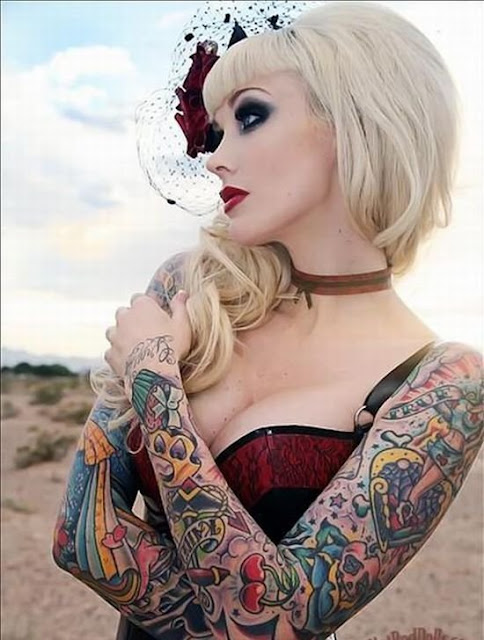 As the society of Edo progressed, the ordinary people began to take pride in activities of fashion. Gradually, the Edo working class people began to imitate the heroes from the folk stories they used to read in the books (especially the picture books) and comics and other artworks as popularized by the famous woodblock artist Kuniyoshi. Getting highly impressed from these artistic works, the people began to tattoo themselves ritualistically and painfully with the designs based on folklore, such as dragons, Chinese lions, and giant snakes, and also with religious figures with the help of sharp needles for inserting pressed charcoal ink under their skin.
As the society of Edo progressed, the ordinary people began to take pride in activities of fashion. Gradually, the Edo working class people began to imitate the heroes from the folk stories they used to read in the books (especially the picture books) and comics and other artworks as popularized by the famous woodblock artist Kuniyoshi. Getting highly impressed from these artistic works, the people began to tattoo themselves ritualistically and painfully with the designs based on folklore, such as dragons, Chinese lions, and giant snakes, and also with religious figures with the help of sharp needles for inserting pressed charcoal ink under their skin. The people who carried out the process of tattooing were mostly the woodblock artists who simply had to exchange their wood-carving blades for long and sharp needles. With time, some of these people became so much involved with tattooing that common people began to accept them as tattoo specialists. This is how the unique Japanese traditional body art form, horimono was formed.
The people who carried out the process of tattooing were mostly the woodblock artists who simply had to exchange their wood-carving blades for long and sharp needles. With time, some of these people became so much involved with tattooing that common people began to accept them as tattoo specialists. This is how the unique Japanese traditional body art form, horimono was formed.Today, it is very common to have tattoo conventions in Japan as well as in the West. But to have such conventions in the Edo period in Japan around 150 years earlier is itself a strong indicator of the Japanese having a long and rich history of tattoo culture. Even though there are no photographic record of their works and designs, lot of books are available today which describe the life and work of many tattoo artists of the Japanese Edo period.
 One very famous tattooist from the Edo period is Horiuno. Horiuno was born in 1843. He became a tattooist at the age of 20. But before beginning to work full time from his age of 40, he travelled extensively throughout Japan, going from place to place like Osaka, Kyoto and Shizuoka. However, he continued doing his business well into his seventies and much of his work can be seen even today. Most of his customers used to work in the local construction and manufacturing industries, and in 1912, some of these people of the Kanda area formed the Kanda Choyu-kai, meaning "Tattoo Friends Society of Kanda", and after another 10 years, the society was extended to outside the Kanda area, and formed the Edo Choyu-kai.
One very famous tattooist from the Edo period is Horiuno. Horiuno was born in 1843. He became a tattooist at the age of 20. But before beginning to work full time from his age of 40, he travelled extensively throughout Japan, going from place to place like Osaka, Kyoto and Shizuoka. However, he continued doing his business well into his seventies and much of his work can be seen even today. Most of his customers used to work in the local construction and manufacturing industries, and in 1912, some of these people of the Kanda area formed the Kanda Choyu-kai, meaning "Tattoo Friends Society of Kanda", and after another 10 years, the society was extended to outside the Kanda area, and formed the Edo Choyu-kai. All the members of this group, who are mostly labourers such as construction workers, carpenters and plasterers, meet every year at places like Ojinanushi-no-taki and Marukotamagawaen, take part in mass outdoor banquets, or in festivals such as the Asakusa Sanja-matsuri, and present their intricate and extensive body art tattoos with pride. Horiuno was known as the most talented tattooist from Japan and was famous throughout Japan and also overseas. However, at that time there were many other equally skilful tattooists in Japan, such as Horikane, Kyuta, Horiiwa, and Nekokichi.
All the members of this group, who are mostly labourers such as construction workers, carpenters and plasterers, meet every year at places like Ojinanushi-no-taki and Marukotamagawaen, take part in mass outdoor banquets, or in festivals such as the Asakusa Sanja-matsuri, and present their intricate and extensive body art tattoos with pride. Horiuno was known as the most talented tattooist from Japan and was famous throughout Japan and also overseas. However, at that time there were many other equally skilful tattooists in Japan, such as Horikane, Kyuta, Horiiwa, and Nekokichi. If you have grown tired of your tattoo and want to have it removed there are a number of options available, home and DIY methods have worked for people but the highest success rate comes with surgical methods. To remove a tattoo with excision can be costly but it's far less painful with a greater success rate. Take a look at the effect of tattoo excision.
If you have grown tired of your tattoo and want to have it removed there are a number of options available, home and DIY methods have worked for people but the highest success rate comes with surgical methods. To remove a tattoo with excision can be costly but it's far less painful with a greater success rate. Take a look at the effect of tattoo excision.














No comments:
Post a Comment